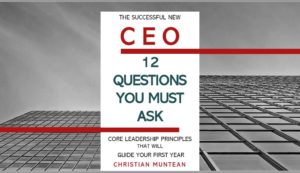Difficulty Finding People to Hire? Make Sure You Do This.

 A local paraglider recently made the news flying nearly 100 miles over the Alaskan wilderness. To do this, he climbed thermals (columns of warm, rising air) to gain and regain altitude.
A local paraglider recently made the news flying nearly 100 miles over the Alaskan wilderness. To do this, he climbed thermals (columns of warm, rising air) to gain and regain altitude.
By circling up through a thermal, he gained the altitude needed to allow him to fly further. Further flight increased his chances of finding another thermal.
One success supported another which, in turn, reinforced more of the first success. And on it went for 100 miles of unpowered flight.
This is called a virtuous cycle or positive feedback loop. Success begets success.
In organizations, some dynamics work together to continue to lift each other and the organization up.
There is, of course, an opposite effect as well. The vicious cycle or negative feedback loop.
View Employee Engagement as a Blood Pressure Reading
According to a recent study done by Gallup, only 39% of employees feel engaged at work. The good news is that this is a slight increase over the previous year.
The bad news is that engagement amongst managers hasn’t risen. In fact, it has dropped to 33%. This is not good. Amongst other negative consequences of disengaged management, they are likely to drag overall engagement back down.
This matters. A highly engaged workforce is not only more attractive to be at but will experience less turnover, higher productivity, less unhealthy conflict, better customers service, and so on.
As a result, employee engagement is a useful way to gauge your organization’s pulse and pressure. A healthy reading is a good indicator that you are doing well and will likely continue to do so.
Unfortunately, Gallup’s numbers suggest that most organizations in the United States are trapped in some form of vicious cycle. A negative feedback loop.
Their blood pressure reading isn’t what it should be. Something is wrong.
Good News: The Virtuous Cycle Is A Choice
Now the Gallup stats are averages – of mostly average organizations.
In real life, averages are mathematical observations. Not experiential realities. Most organizations, including yours, are typically above or below average.
Which is your organization?
And in this case, the average is so unhealthy, if you aren’t well above average, you are spending far more time and resources than are perhaps appreciated fighting a vicious cycle.
But…you can choose to build a Virtuous Cycle into your workplace.
A Key Ingredient for an Engaged Workforce
I’ll give the simple answer first: To build an engaged workforce – leadership must be engaged in driving change. Disengaged (or self-engaged) leadership will breed more of its own throughout the organization.
All across the economy, employers are struggling with finding enough employees (let alone ideal and engaged employees).
In spite of this, my counsel to my clients has been to focus on attracting ideal employees – high performers. Especially for key positions. Why?
Because high performers not only produce more, but they help you create the kind of culture that cultivates a Virtuous Cycle. This assumes you actively build that culture with them. If you don’t, they’ll leave.
A different Gallup study showed that truly high performers were responsible for dramatically higher performance than others. In fact, it showed that the Pareto Principle was true in this context as well: Roughly 20% of your employees are likely responsible for 80% of organizational performance.
High performers are not like everyone else. They aren’t just incrementally better. They are geometrically better. They are influencers. They are force multipliers.
And they don’t respond to the same things as everyone else. You can’t recruit or retain them the same way. They are attracted to a certain kind of culture.
You Can’t Build a Virtuous Cycle Out of Vicious Ingredients
Unfortunately, when most employers think about trying to boost engagement or performance, they think about carrots and sticks. Incentive programs or perks. Writing people up or laying people off.
Right now, it’s so difficult to get people to work, it’s popular to offer signing bonuses to new employees.
I’ve read debates online about whether or not the bonuses are big enough or worth it. Here’s the thing – what kind of employees are most attracted to signing bonuses?
There is large public debate over wages and the minimum wage in particular. According to repeated, validated research, who does this matter the most to?
Average employees.
Not high performers. Now, high performers will expect to be equitably compensated. And they should be. But compensation isn’t a primary driver.
Here’s what the studies show motivates high performers the most – I’m listing them in order of greatest to least impact:
- The quality of relationships with co-corkers
- The ability or freedom to do their best work
- Receiving recognition and encouragement from their employer
- Having a sense of purpose or impact
- Opportunities for personal or professional growth
- Being able to meet the needs of others
- Compensation
- Positive management & leadership at the company
- Belief in the company or product
- Other
Compensation comes in 7th. In some studies, it is a little higher or a little lower. But it is always down on the list when referring to high performers.
It is worth noting that most of these items have nothing to do with creative incentives or perk programs or having a ping-pong table or a kegerator at work.
You have to go to the truly mercenary employees where pay is what matters most.
Here Is How to Build a Virtuous Cycle That Attracts and Retains the Best
What matters most to high performers is good relationships, with people they respect, giving their best work to something they feel is purposeful and challenging.
That’s a description of culture.
A savvy leader recognizes you can’t go on Amazon and buy a great culture. An HR department can’t write a policy for it. They can train their little hearts out – but trainings don’t create it.
You, the leader, have to create, nurture and protect.
Build that culture, a culture that produces the items on the list above, and you’ll discover that high-performers will come looking for you. Even some average performers will be inspired by your high performers and raise their own game.
Building a culture that engages high performers is one of the Seven Essential Executive Skills. If you’d like to learn all the Seven Skills, pick up a free copy of my book, The Successful New CEO. Experienced CEOs have told me that they felt like every leader should have a copy of this book – not just new CEOs. So get your copy today.
Take good care,
Christian
For more reading on the topic:
The Leader’s Guide to Culture Change
How Does Culture Improve Performance?
Let’s connect.
I’m passionate about helping leaders to create workplaces they love going to and increasing the value of the services they offer. My results-oriented approach is tailored to each client’s specific situation and needs. As a leadership coach, I have developed a wealth of resources to help you and your team grow and become stronger.
Weekly Newsletter – sign up to receive my weekly articles addressing critical leadership challenges and issues.
The Leadership Coach Podcast – In my podcast, we explore effective, high-impact, and enjoyable leadership. Subscribe.
Resources – Visit my website’s Resources page for e-books, webinars, training, and leadership coaching opportunities for you and your team.
There are 𝟭𝟮 𝗰𝗿𝗶𝘁𝗶𝗰𝗮𝗹 𝗾𝘂𝗲𝘀𝘁𝗶𝗼𝗻𝘀 to ask before accepting a new CEO position. Do you know what they are? Instantly download my free e-book here.
Find the value of your company with my free assessment tool: The Value Builder System
The Value Builder System™ is a 13-minute online questionnaire that evaluates your business on the eight factors that contribute more to its attractiveness and value. These factors are scored on a scale of 1-100. Businesses that score over 80 are likely to command 70%-100% higher value than others.
Opportunities
Free Resource: How To Accomplish More Without Doing More is a workbook I created to walk leaders through a process of helping you own your calendar, liberate your time, and still get more done. Download it for free!
Executive and Leadership Coaching: Do you feel overwhelmed? Are you not getting the results you expect from the effort you are putting in? Do you find yourself facing similar challenges time and time again? Would you like to change specific ways of relating or reacting? If you would like to experience predictable, measurable growth Contact me.
Profitable Exit Strategy Workshop: Are you a business owner or partner? Over 55? Starting to think about exiting your business or active management in the next 3-5 years?
- Curious about what your business might be worth?
- Would you like to discover the specific steps you need to take to increase its value and become highly attractive to a buyer?
- Are you planning on handing it over to family or employees and you want to ensure long-term success?
If so, contact me now
Article Categories
Popular articles

Download my free 10-page eBook:
How To Accomplish More Without Doing More:
Eight Proven Strategies To Change Your Life
Discover how to save eight hours during your workweek-even if you're too busy to even think about it. The resource every maxed out executive needs.

